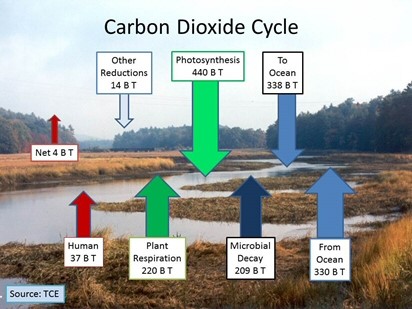Climate Illuminated

Examining Carbon Cycle

Guest Blogger / 3 hours ago May 21, 2017
Guest essay by Ronald R. Cooke
In high school and college I did reasonably well in the physical sciences: chemistry, physics and geology. From these studies one can learn that carbon (C) is an element, is widely available throughout our universe, is chemically active (which means many inorganic and organic compounds include carbon), is present in the atmosphere as carbon dioxide, is present in all natural fresh and ocean water, is a component of rocks (such as limestone), is a primary element of buried organic materials (including hydrocarbon deposits of oil, coal and natural gas), and is a very important element of the human body (about 18.5% of the elements in our body by mass). In fact, all life on this planet is based on hydrocarbon compounds which include carbon, hydrogen and oxygen.
By contrast, carbon dioxide (CO2) is a colorless, tasteless and odorless gas that occurs naturally everywhere in, on and above our planet. Carbon dioxide is not carbon, but it does include one carbon atom and two atoms of oxygen. Carbon dioxide occurs naturally in the atmosphere. Higher levels of CO2 encourage the growth of stronger and more abundant plants. All plant life (a form of organic matter) has been produced by the interaction of CO2 with energy received from the sun (sunlight + H2O + O2 + CO2 = photosynthesis). All oil, natural gas and coal are derived from buried organic matter which has been compressed and heated over millions of years.
We humans would not exist if there were no CO2 in the atmosphere. We either eat the results of photosynthesis directly (when we consume grains, fruits and vegetables), or indirectly (when we eat animals, birds and fish that have previously consumed plant life). The natural metabolism of the body produces CO2 as a byproduct which we (like all animals) exhale when we breath.
Thus it makes no sense to examine the carbon cycle (an element) when we are really interested in the carbon dioxide cycle (a gas); most specifically we want to know how CO2 is produced and consumed, as well as how much residual CO2 there is in the atmosphere. In the following graph we show the primary categories of how CO2 exchanged with the atmosphere. Down arrows represent a decrease in atmospheric CO2. Up arrows represent an increase in atmospheric CO2. The size of the arrow represents the relative importance of each category. The importance of each category as a percentage of global CO2 is shown by the accompanying table.

|
Carbon Dioxide Cycle |
|
|
|
Increase |
||
|
CO2 |
||
|
Levels * |
||
|
Plant Respiration |
220 |
27.6% |
|
Decay of life forms |
209 |
26.3% |
|
Sea Surface |
330 |
41.5% |
|
Human Caused |
37 |
4.6% |
|
797 |
100.0% |
|
|
Decrease |
||
|
CO2 |
||
|
Levels * |
||
|
Photosynthesis |
440 |
55.6% |
|
CO2 taken by soils |
6 |
0.8% |
|
Sea Surface |
338 |
42.6% |
|
Conversion of CO2 |
8 |
1.0% |
|
792 |
100.0% |
|
|
Human Caused CO2 |
4 |
|
|
As a % of total CO2 |
4.7% |
|
|
Annual net increase |
0.55% |
|
|
*Gt (Rounded) |
||
Increase Atmospheric CO2
A plant takes up water (H2O), carbon dioxide (CO2), oxygen (O2), and minerals through its roots. It also exchanges carbon dioxide, oxygen, and water with the atmosphere through its leaves and stem. It uses the energy of sunlight to convert these into sugars and starch through a process called photosynthesis. These are then used by the plant to increase its size and biological activity (growth of leaves, stems, roots, fruits, seeds, and so on). In so doing, excess plant energy is given off as heat (respiration).
A typical process is: 6CO2+6H2O+energy (from the sun) = C6H12O6+6O2 (sugars). Notice there are 18 oxygen atoms going into the process and only 12 are used up. In photosynthesis the 6 excess O2 gas is released into the atmosphere. The respiration process is C6H12O6+6O2 = 6CO2+6H2O + energy (some as heat). Respiration releases CO2 and water into the atmosphere (and soil). Photosynthesis is a primary source for the oxygen we humans breathe in order to stay alive.
Microbial decay (decomposition of matter) is a process that starts soon after a plant or animal dies. Organic material is broken down into basic elements. Decomposition always includes the release of CO2.
Plant decay includes water leaching which liberates soluble carbon compounds, including CO2. Smaller plants are largely decomposed by soil invertebrate fauna. The decomposition of larger plants (like trees) typically involves parasitic life-forms such as insects and fungi. Microbial colonization accelerates the attack on plant cells. In the last stages of decay, cellulose, hemicellulose, microbial products, and lignin are chemically altered by microbes.
We humans, along with other animals, begin to decay almost immediately after death. The tissues of the animal body are broken down by internal chemicals and enzymes. Bacteria invade the tissues and start the process of putrefaction. Gases, including CO2, are released by decaying animal tissue.
Although we do not have sufficient knowledge to establish all the dynamics of the CO2 gas exchange between the surface of the ocean and the surrounding atmosphere, it is estimated that slightly more CO2 is absorbed by the ocean than is released by the ocean surface into the air. It is both a physical and a chemical process that is primarily controlled by the differential between the concentrations of CO2 dissolved in the water and how much CO2 is available in the surrounding atmosphere. Since CO2 is soluble in water, we get the chemical equation CO2 + H2O = H2CO3, a weak form of carbonic acid. In the presence of free hydrogen H2CO3 + H = yields a bicarbonate ion which is stored within the waters of the ocean. The amount of CO2 which has been dissolved in the waters of the ocean varies with geographic location and the circulation patterns of the ocean currents. Higher concentrations are more likely to be found in the more populous and industrialized northern latitudes.
We humans release CO2 into the atmosphere when we breathe, raise animals, cut down trees, shrubs and grasses, burn peat and plants, consume fossil fuels, and so on. Our consumption of coal, oil and natural gas is by far the largest source of human caused CO2 because we consume large quantities of these fossil fuels by the process of combustion (burning). Gasoline, diesel, jet, and heavy fuels provide the energy that powers our transportation system, including personal vehicles. Natural gas, propane, heating oil, and kerosene heat our buildings and homes. Coal and natural gas are primary sources of the heat for the generation of electrical energy. As shown by the above table, we release about 4 billion tons of CO2 into the atmosphere each year; accounting for roughly 4.7 percent of all CO2 that is released into the atmosphere from all sources (natural and human caused). Because of human activity, total atmospheric CO2 is increasing bout .55 percent each year.
Photosynthesis
Plants consume far more CO2 through the process of photosynthesis than they release into the atmosphere through the process of respiration. These chemical reactions make plants green (usually), help them to grow stronger, and increase the rate of growth. For plants, more CO2 is better and there is some evidence that elevated levels of CO2 in the atmosphere have increased the greening of our planet. Plants, including trees, shrubs, grasses and crops, exchange CO2 with the atmosphere through their leaves and stems, and with the soils in which they live through their roots. At least 35 percent of available man-made C02 is consumed by plant life on our planet.
CO2 Taken by Soils
Since CO2 is soluble in water, damp or wet soils will take up CO2 where its chemical components may combine with other chemicals in the soil to produce other compounds.
Sea Surface
As discussed above, the ocean – along with lakes and rivers – removes more CO2 than is released into the atmosphere.
Conversion of CO2
Chemical conversion includes biological and chemical conversion of CO2 into other compounds, and effect of water vapor on CO2 in the atmosphere.
Our model estimates that in 2015 we humans will cause the production of an estimated ~ 37 Gt of CO2. By way of comparison, the PBL Netherlands Assessment Agency has estimated in 2013 we humans were responsible for 35.3 Gt of CO2 from combustion of fossil fuels and industrial processes. It should be noted some scientists estimate human caused CO2 is significantly less than our estimate.
Human caused CO2 is ~ 4.7 % of total global CO2 emissions. This figure includes both combustion and non-combustion industrial processes (manufacture of plastics, fertilizers, paints, asphalt, cosmetics, etc.), agricultural land use changes, deforestation and logging, as well as CO2 from forest and peat fires.
The Annual Net Increase of global atmospheric CO2 is ~ .55% in our scenario for 2015. This percentage is approximately the same as the average annual mean of increased atmospheric carbon dioxide observed by NOAA ESRL at the Mauna Loa Observatory in Hawaii over the last 14 years ( ~ .54 % 2000 – 2014). A contraction of economic activity in future years will decrease man-made CO2 emissions.
As we have shown: chemical decomposition, photosynthesis, and absorption eventually remove man-made carbon dioxide from the atmosphere. It’s all a natural process.
TCE
We should revisit occasionally what the proper role of government is. As the constitution was a good sense of direction, we need a core set of principles to add in order to deal with the future.
So many want to engineer society, remove risk, assist certain groups, rather than let individuals thrive and raise communities. Why?
Is Democracy where we all "get it good and hard" or is it the best means to a free society?
Should we roll with the special interests, or make the government achieve its proper role, what is that role, and how to do this?
When do deficits and governments become too large?
Government is becoming more elitist while trying to sell corrections to problems it created, what makes this possible?
This could also be inserted into the field above, or erased
Currently as a society, we are having a most difficult time discussing political issues. What is driving this? And why a rebirth in political culture would be a good thing.
Are "markets" dead as some would conjecture? Or is free enterprise what got us here?
At the heart of economics there are several possible economic schools of thought, the essence of these schools of thought and how they relate to our lives.